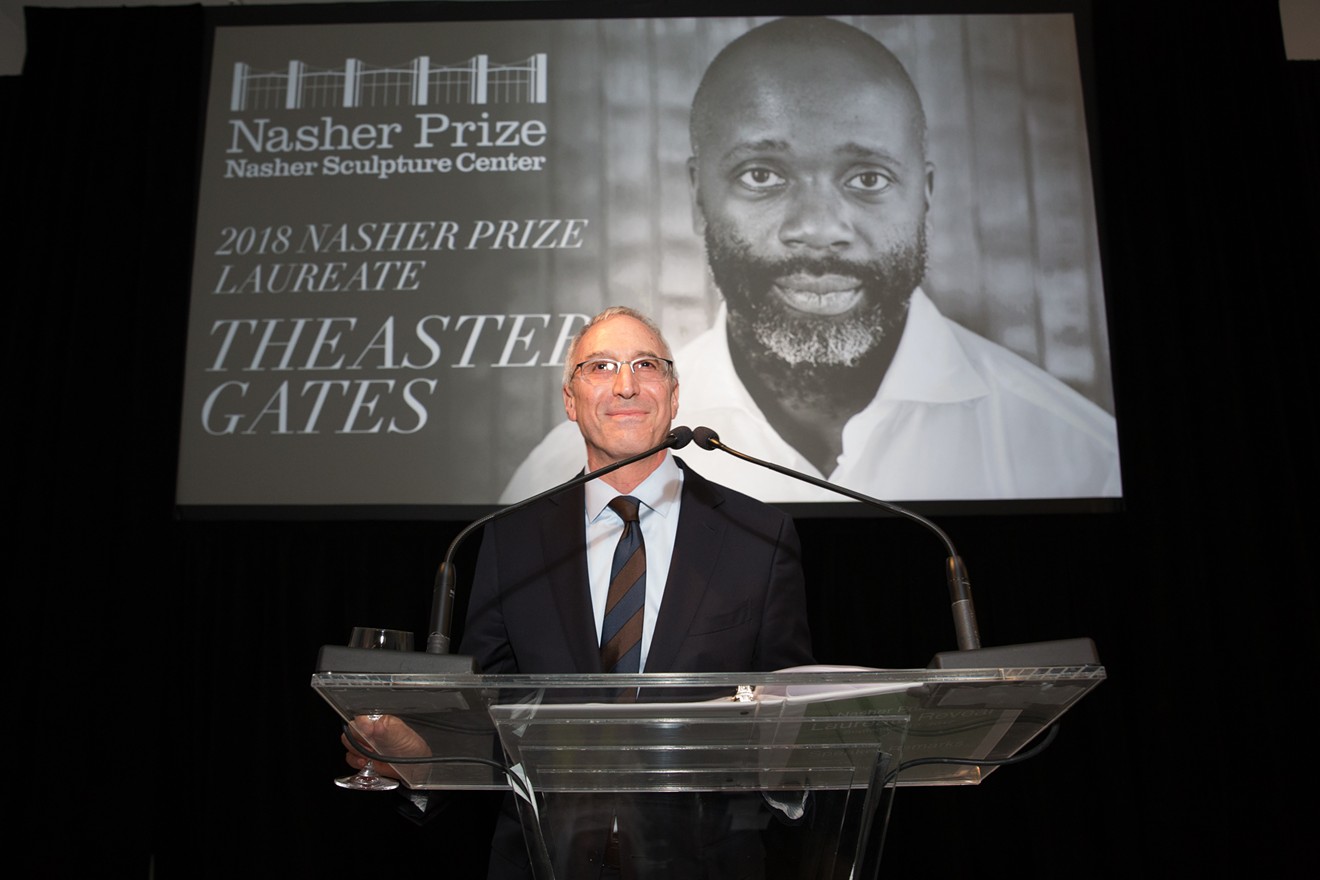Each summer, a handful of jurors meet at the Tate Britain in London to deliberate the nominees. The top-secret process produces a winner, who's unveiled in Dallas each fall. Throughout the year, associated events, like the Nasher Prize Dialogues, take place in Dallas and cities around the world.
In 2017, French artist Pierre Huyghe was chosen for his ability to expand the parameters of sculpture, approaching the medium less as an object and more as an ecosystem. Huyghe creates environments and landscapes that incorporate such vast materials as biological organisms, fog and ice with music and performance.
The year before that, Colombian artist Doris Salcedo was honored for her ability to transform everyday objects into powerful remembrances of love and loss from her conflict-ravaged home country.
It’s no surprise that the 2018 laureate unveiling, announced at the Warehouse last Tuesday evening, drew Dallas’ elite art world. After an hour of cocktails and hors d’oeuvres, Nasher Sculpture Center director Jeremy Strick announced Theaster Gates as the new Nasher Prize recipient.
A Chicago native, Gates is not only a sculptor but also a social practice artist dedicated to the revitalization of underprivileged neighborhoods through urban planning and art. He uses found and repurposed materials, often historic or from the building he’s renovating, to create new sculptural works that honor time, memory and culture.
We sat down with Strick after the unveiling to ask him about the origins of the Nasher Prize and how Gates was chosen as this year’s laureate.
How’s your night been?
It’s been fantastic. The jury made their selection this summer, so we’ve been preparing for this night since then while keeping it a secret or doing our best to keep it a secret. Just to be able to finally make the announcement is so satisfying. And the response is more than I could have hoped for.
How many people become finalists?
What happens is we invite about 150 people from around the world — artists, curators, scholars, museum directors — to each nominate an artist, and then those names are provided to the jury. We put together dossiers on each of the nominees, and then the jury meets. It ends up from those 150, about 100 artists are nominees. The jury discusses them all, and then through a series of votes, whittles it down. With each vote, there are fewer and fewer until at the end of the day, we end up with the laureate.
That’s a laborious process. What stood out to you, and how did you choose this year’s laureate, Theaster Gates?Theaster Gates is "an artist whose work speaks very powerfully to this time and to the history of this country." – Nasher director Jeremy Strick
tweet this
I think the jury thought a lot about the nominees. It was really an amazing range of work. I mentioned the origins: 25 countries and six continents, but also the kinds of work and the kinds of artistic practices that were represented.
There were object makers, people working in ways that have a lot of history behind them. At the same time, there has been this extension of the purview of sculpture into things like sound and light, social sculpture, social practice. The jury had recognized some of that expansiveness with Pierre Huyghe, last year’s laureate, and they were sort of torn.
It’s not that there were factions between jurors; it was that each juror felt within themselves a pull in one direction and another — an attraction to this artist who’s making objects that are so compelling, this artist has a practice that is so compelling. They also wanted to think about: What is meaningful right now? What is the world right now? Who is setting an example that other artists are looking at?
They found in Theaster Gates an artist who, in a certain sense, does everything. He has origins as a potter — one of the oldest forms of sculpture. His work has expanded into all kinds of disciplines, and he does work in a social context. But his work always comes back to that material quality. And he’s an artist whose work speaks very powerfully to this time and to the history of this country, of his community, of his neighborhood. Theaster Gates brings a lot of things together — a lot of concerns and ideas — and I think the jury responded to that.
How was the Nasher Prize first developed? I’m curious how y’all decided it was worth doing and necessary to do.
It’s an idea that perhaps even predated the Nasher Sculpture Center. Ray Nasher always talked about the possibility of doing a prize. In the last few years, we began to think about it again. In recent years, the sculpture center has expanded its programs, expanded its purview, engaged to a significant degree with contemporary art — while also continuing to focus on the history of modern sculpture — worked with artists in various ways, from our exhibitions to our speaker series to our Artist Circle. The question was: What else should we be doing?
The purpose of the Nasher is to provide a focal point for the study and appreciation of modern and contemporary sculpture. We realized that the one thing we hadn’t done — that hadn’t been done, period — is a great international prize in sculpture.
What’s important about prizes is they’re a means of recognizing and celebrating excellence. But perhaps a more important function is that they focus attention on a particular practice. The Pulitzer Prize gets everyone thinking about journalism; the Pritzker Prize gets everyone thinking about architecture. It was a great way to advance our mission: the appreciation and the study of sculpture. For us, it was a perfect fit.
I’m shocked that it hasn’t been done elsewhere.
There are various art prizes. The closest thing is the Imperial Prize in Japan. Each year it gives a prize in five areas, one of which is sculpture. But an international prize completely focused on sculpture — that’s the Nasher Prize.
It’s really an armature for more because we hang from that armature the Nasher Prize Dialogues, and that creates an opportunity for discussions in Dallas and in cities around the world.
Have you seen a direct effect of the Nasher presenting itself on the world stage with the Nasher Prize?
People in Dallas have been excited about that; it’s a sense that they’re participating in this international conversation. I think that what we’re doing matters. Like when we had the Nasher Prize Dialogues in Mexico City earlier this year in partnership with Museo Jumex, we had a full house and over 10,000 people watching the livestream from home. There’s an interest in this, and the response to it is meaningful.












